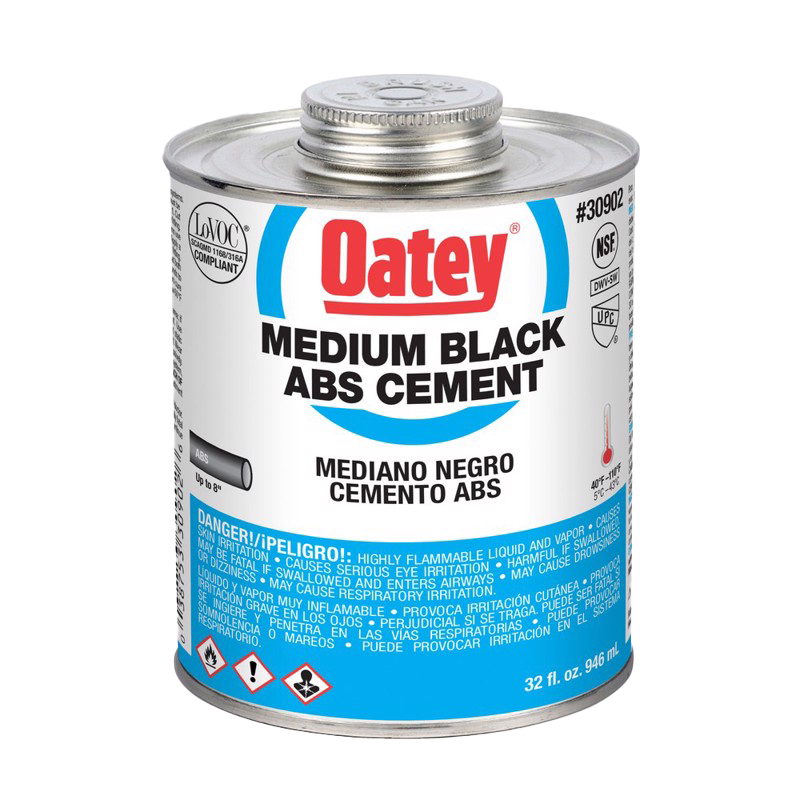So many cements, so little time – right? Whether you’re a new pro entering the industry, a seasoned plumber in need of a quick refresher or a recent homeowner attempting your first DIY project, we’re here to help you select the most effective and efficient solvent cement* for every job.
Below, we’ve included expert tips along with suggested products – think of these as your cement “staples” – that will keep you prepared for various plumbing applications, repairs and emergencies.
WHAT SHOULD YOU CONSIDER BEFORE SELECTING A SOLVENT CEMENT?
Pipe Material
First, determine if you will be joining PVC (Polyvinyl Chloride), ABS (Acrylonitrile Butadiene Styrene) or CVPC (Chlorinated Polyvinyl Chloride) plastic pipes and select corresponding cements. For example, use PVC cement for PVC pipe fittings and ABS cement for ABS pipe fittings.
This is arguably one of the most critical steps in the solvent welding process. If a cement and pipe material aren’t compatible, then the pipe and fitting cannot chemically fuse together leading to joint failure.
Pipe Size
Next, consider the size of the pipes. Larger pipes will require a cement with a thicker viscosity, or a heavier body. You can choose from regular, medium and heavy bodied cements.
As a general rule of thumb, our experts recommend using the following pipe size guidelines when selecting a solvent cement. You can also find the maximum recommended pipe size listed on the cement can.
|
Cement Body |
All Schedules |
Pressure | Non-Pressure |
|---|---|---|---|
|
Regular |
|
Up to 2" | Up to 4" |
|
Medium |
Up to 6" |
||
|
Heavy |
|
Up to 12" | Up to 18" |
| Extra Heavy | Up to 24" | Up to 30" |
*Schedule = Wall thickness of the pipe
Application Conditions
Additionally, confirm that a cement is rated for the temperature, moisture and pressure conditions of the application site. You should also consider whether you’re working on a potable water system or a non-pressure DWV (Drainage, Water and Vent) system and select the formulated cement for that particular application.
Set time, also known as cure time, of cement should also be evaluated. For example, if you have time-sensitive project where the plumbing system cannot be down for an extended period of time, you should opt for a faster setting product.
Local Codes and Standards
Finally, ensure the solvent cement meets all applicable codes and standards based on application site.
Now that we’ve summarized the steps you can take to ensure you’ve selected the best cement, here are some product suggestions that will help you tackle the most common plumbing applications.
WHAT CAN YOU USE TO JOIN PVC?
Medium Clear PVC Cement: Fast drying and suitable for potable water, pressure pipe, conduit and DWV applications. It’s approved for use up to 6” in all schedules and classes of PVC pipe and fittings. Recommended application temperature is between 40°F and 110°F / 4°C and 43°C.
Ideal for projects with multiple pipe diameters, as well as both residential and commercial applications due to its approval for use on pipes up to 6’’.

Heavy Duty Clear PVC Cement: Select a heavy duty cement for use on all larger schedules and classes of PVC pipe and fitting up to a 12’’ and up to 18’’ for non-pressure. It’s recommended for potable water, pressure pipe, conduit and DWV applications with temperature ranging from 40°F to 110°F / 4°C to 43°C.
Best for commercial applications, as it is approved for use on larger diameter pipe.
Hot Medium Blue Lava PVC Cement: Extremely fast setting and the preferred formula for emergency, repair and cut-in work for potable water, sewer and DWV applications. It is also formulated to hold PVC joints beneath water.
A go-to cement for pool/spa and irrigation contractors.
WHAT CAN YOU USE TO JOIN ABS?
ABS Medium Black Cement: Recommended for residential, non-pressure applications on all schedules and classes of ABS pipe and fitting up to 6’’. Can withstand temperatures between 40°F and 110°F / 4°C and 43°C.
Remember: Unlike PVC and CPVC fittings, never use primer on ABS solvent welds.

WHAT CAN YOU USE TO JOIN CPVC?
Orange Lava CPVC Cut-In Cement: Fast-setting cement formulated for time-sensitive repair and cut-in work. This one-step cement does not require a primer where local codes permit. It is heavy bodied for use on all schedules and classes of CPVC pipe and fitting up to 12’’.
FlowGuard Gold 1-Step Yellow Cement: Ideal for CTS (Copper Tube Size) cold and hot potable water pipe and fitting up to 2’’. It’s recommended for cold water systems and hot water systems up to 200°F / 93°C. This one-step cement does not require a primer where local codes permit.
More common for residential applications.
Medium Orange CPVC Cement: Suggested for both residential and commercial cold and hot water systems with temperatures up to 200°F / 93°C. Approved for use on all schedules and classes of CPVC pipe and fitting up to 6’’ and requires the use of primer.
Suggested for commercial applications.

WHAT CAN YOU USE TO JOIN ABS AND PVC?
ABS to PVC Transition Green Cement: Used when joining ABS to PVC in non-pressure transition joints up to 6’’. Many jurisdictions will allow the use of this cement for one transition between ABS and PVC piping per application.
Recommended when a mechanical transition cannot be accomplished.
*Note: You’ve likely heard solvent cement referred to as PVC glue, pipe glue, cement glue or plumbers glue. These terms are often used interchangeably but are technically incorrect. When a pipe and fitting are joined, they form a solvent weld - they are not glued. They are softened, chemically bonded and cannot be taken apart.